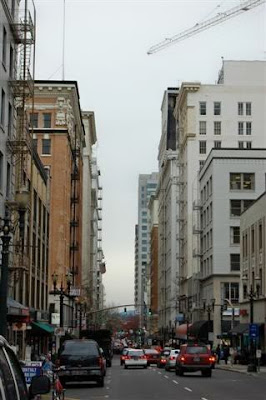Photo of the MAX Light Rail from the TriMet website.
My friend, Robin, and I flew to Portland on United Airlines. Flying sucks anymore, so all I'll say is that we got there on schedule. We were given instructions by our host to take the Light Rail from the airport to downtown. Neither Robin or I visit big cities very often, so figuring out how to work the Light Rail system was pretty comical. We had to ask for help buying our tickets, reading the maps, determining which train to get on, etc. Once on, however, it was quite interesting. It starts out just like any other train, running on tracks off by themselves, but then all of a sudden, you are in the city on the streets right along with the cars, bikes, and people. It was pretty cool!
Photo from PortlandNeighborhood.com.
Robin and I are fairly educated people who have traveled widely without any problems, but navigating Portland on foot was a challenge. Not sure why, but we had to pull out our street maps over and over again to find our way to the hotel where we would be staying for the next three nights. It didn't get any better over time, either. Not sure why we found Portland so confusing!
Photo of king bed room from the Hotel Deluxe website.
The Hotel Deluxe was a real treat and I highly recommend it. It is a beautifully renovated historic hotel. It's decorated in an old glory days of Hollywood theme and it suits it well. The rooms are small, but well appointed. And the renovation is astounding. Ornate ceilings, period furniture, black and white movie photos. Wonderful. It has a restaurant and a lounge. Our first dinner there was delightful. I had crab cakes, a sizzling wild mushroom plate, and a local brew. We also ate three breakfasts there. They were interesting, but could have been seasoned more and the service was slow. But, I'm willing to wait a little while for crab and shrimp eggs benedict!
Photo from the World Forestry Center website.
Our meetings were held at the World Forestry Center next to the zoo in Portland. That was an interesting place that I wish we had more time to explore. Very well done with detailed, colorful exhibits.
Photo from the Henry's Tavern website.
Eating and drinking in Portland was delightful. Since I am doing research on hops, I felt it was my duty to sample as many hops products as possible. Lunch the first day was at Henry's 12th Street Tavern. What a treat! Interesting interior architecture with great attention to detail. Wonderful service. Over 100 beers on tap. I had the grilled wild Alaskan Coho salmon sandwich with lemon artichoke tartar on a brioche bun and a little jar of their pickle slices. With a local beer made with Citra hops, giving it a fresh, citrusy flavor, it was the perfect welcome to Portland lunch.
We also had dinner at the BridgePort BrewPub in the historic Pearl District. I had a juicy lamb burger with feta cheese and roasted tomatoes on a bun. Another dinner was had at Deschutes Brewery & Public House. We started that dinner with some black truffle fries and I had a delicious Cuban sandwich with a bit of a bite to it.
Photo of a queen room from the McMenamins Edgefield website.
Our last evening was spent at the Edgefield in Troutdale, Oregon. I don't know how to describe this place and do it justice! This is a 1911 county poor farm that has been loving renovated into a very unique inn complex with multiple venues including entertainment, pubs, gardens, and a spa. Whimsical is the best way to describe the decor. Even though you are very close to an urban area, you feel far removed on the 74 acre property. There are no televisions or phones in the rooms. There are big porches to sit on and lots of room to roam. My only complaint was that the room I stayed in used common bathroom. Very well appointed, but for me a bit of hassle because I kept forgetting things and having to go back to my room. But not all the rooms are like that. So I would definitely stay there again and just get a room with a private bath.
All in all, it was a wonderful trip. Next time I would like to take hubby with me and stay awhile longer, but I'm not sure he could handle that long flight. So, maybe a very extended road trip in a RV??

















